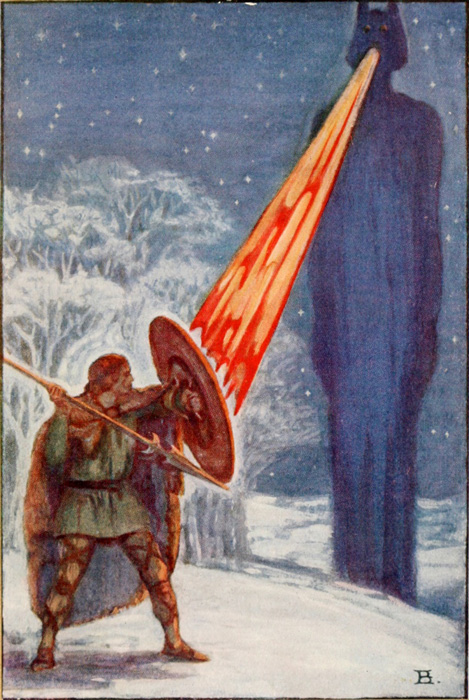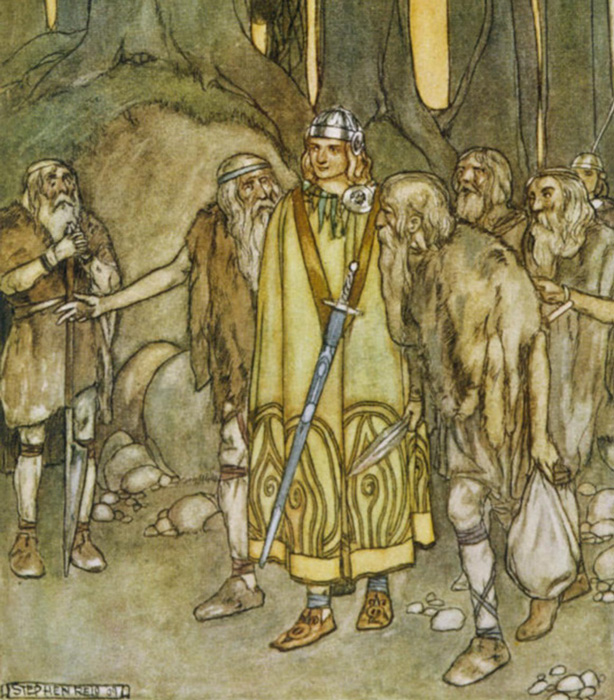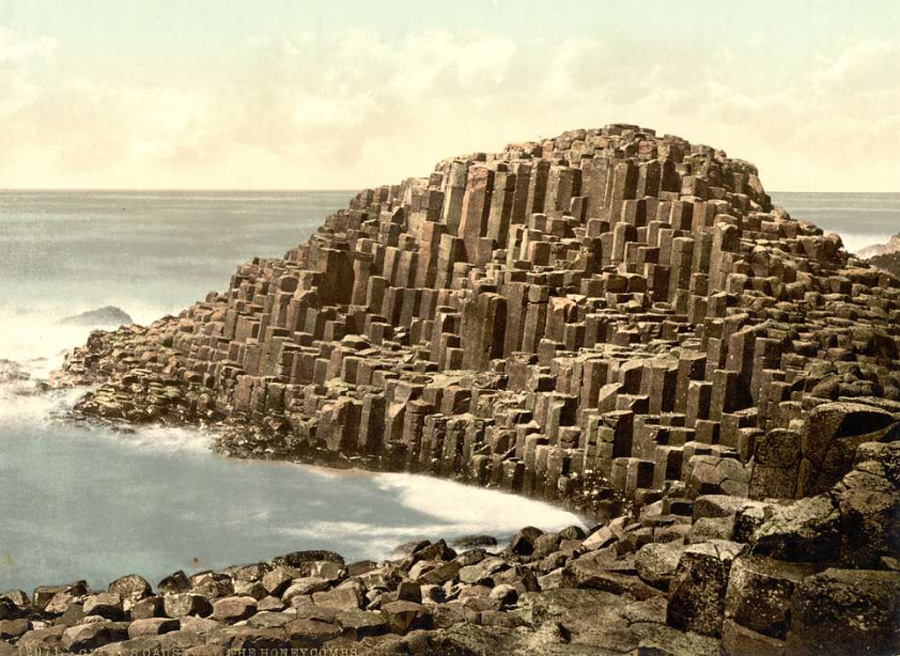60 million years ago, an intense volcanic eruption forced molten basalt rock through the upper layers of chalk, forming a flat plateau of volcanic rock. As the lava cooled, it contracted into basalt columns, forming the Giant’s Causeway, in Ireland.
At least, that is the scientific explanation. Irish tradition, however, has a far more colorful tale to tell. For the poets of the oral tradition, the Causeway was built by the legendary Irish warrior Fionn mac Cumhaill, anglicized as Finn McCool, to avoid getting his feet wet.
The stories of Finn McCool are ancient indeed, associated with the peoples who lived in Ireland before even the Celts inhabited the land, around the 3rd century BC. Sometimes a hunter, sometimes a giant standing 54 feet (16 m) tall, Finn McCool looms large in the prehistory of Ireland and the Isle of Man.
Much of Irish tradition and history is lost to us, as enigmatic as the druids of pre-Roman Britain. But the stories of Finn McCool and his travelling companions as told by his son, the legendary poet Osheen (Oisín) have been preserved down the centuries.
Who was this man, around whom so many legends and local stories pivot?
The Early Life of Finn McCool
Finn McCool was born to Muireann Muncháem, “Muirne of the Beautiful Neck” and Cumhall, leader of the loose-knit warrior bands known as the Fianna. Muirne’s father, the druid Tadg mac Nuadat, had foreseen that the marriage of his daughter would lead to his loss of home.
The Druid therefore rejected any suitor for his daughter and refused to let any lover approach her. However Cumhall was determined to win Muirne and abducted her from her home.
Tadg sought help from the high king of Ireland, Conn of the Hundred Battles, to retrieve his daughter. Cumhall was chased down and defeated by the king’s forces, and killed by Goll mac Morna who became the new head of the Fianna. Muirne was returned to her home, but when she found that she was pregnant her father rejected her in shame.
However, the King intervened and sent Muirne to the druidess Bodhmall, Cumhall’s sister. Under the protection of Bodhmall, Muireann gave birth to Cumhall’s son in Ballyfin, a small village in the heart of Ireland.

Muirne left her son under the care of Bodhmall, knowing that the boy had inherited the enemies of his father, Cumhall. Finn was brought up secretly by two foster mothers, Bodhmall and Liath Luachra (“Luachra the Grey”), in the forests of the Laois mountains surrounding the village, where he grew to be strong and brave.
Finn was taught everything about warfare trained to be a great warrior. As the son of Cumhall he still had friends in Ireland, and he travelled from court to court to complete his education.
The Stories of Young Finn
One of the most famous stories of Finn took place when he first left the forests and mountains in Laois. Fionn met the druid and poet Finnegas in his young years and studied under him for some time.
Finnegas at this time was focused on catching the mythical Salmon of Knowledge from the river Boyne. Anyone who ate the flesh of this salmon would receive all the knowledge in the world. With the help of Finn, the druid was finally able to capture the salmon, and the young warrior was then asked to cook it for the old man.
It is said that Finn burnt his thumb on the salmon while cooking it. When he put the burnt thumb in his mouth to cool it off, he gained the wisdom in the fish. Perhaps recognizing that Finn was fated for greatness, the druid then gave him the whole fish to eat.
It was popularly believed that Finn could call on the wisdom of the salmon at any time from then on, simply by sucking on his thumb.
Later Life of Finn McCool
Once he had grown to be a young man, Finn McCool returned to the Fianna to avenge his father’s death at the hands of Goll and assume his rightful place as their leader. Once victorious, he was promised the hand of the Irish king’s daughter Gráinne.
- Newgrange: Ancient Winter Solstice Temple in Ireland
- Boudica: Legendary Warrior Queen who Defied an Empire
His bride, however, was in love with another, his lieutenant Diarmuid UaDuibhne. On Finn’s wedding night, the princess eloped with Diarmuid, with Finn and his warriors in hot pursuit.

Finn chased and found the pair and they bravely faced their judgement. However, rather than killing them, Finn made peace with the couple, having overheard Gráinne complain to her father about the marriage, and Diarmuid returned to his service.
However, Finn could still be a vengeful man. Years later, when Diarmuid was injured in a boar attack, Finn chose to let him die. Finn was said to have miraculous powers of healing and could have helped his lieutenant, but instead chose to punish him through inaction.
Death of Finn McCool
There are many stories of the death of Finn McCool. Like King Arthur, many traditions believe that Finn McCool is not dead but simply resting with the rest of the Fianna in a cave, somewhere in the Sheebeg and Sheemore hills. The tribe and its leader will only wake up when the Dord Fiann, the hunting horn of the tribe, is blown three times, to defend Ireland in its darkest hour.
Another account written by the poet Cineadhúa Hartacáin talks about how Finn was killed by Aiclech mac Dubdrenn in a battle in County Meath in eastern Ireland. Defeated in battle, the legendary warrior was beheaded and his warriors scattered.
Yet another account claims that the warrior lived till old age and died while jumping the river Boyne, where he had caught the famous salmon many years before. Slipping, he accidentally banged his head on a rock and drowned. His body was carried downstream to Aiclech, who cut off his head to confirm he was dead.
There are many more stories and traditions about this great warrior and hunter, and the companions who travelled with him. Whatever the truth behind them, Finn McCool’s legendary adventures offer a tantalizing glimpse into Irish history.

Many of the stories of Finn McCool also made their way into later Arthurian traditions. The secret tryst between Finn’s parents, the education by druids, and even the stories of his eternal slumber until his country needs him: all were recycled into tales of King Arthur.
Much of the world the man lived in has been lost to time. But with these stories and with the magnificent Giant’s Causeway to serve as a reminder, at least one link to the past, about which so much has been forgotten, remains unbroken.
Top Image: Many of the stories about Finn McCool also appear in Arthurian legend. Source: Dimart_Graphics / Adobe Stock.
By Bipin Dimri